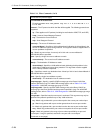
C. Router CLI Commands, Codes, and Designations
9128-A2-GB20-80 September 2002
C-15
DHCP Server Commands
Dynamic Host Configuration Protocol (DHCP) server commands are used to
enable or disable the DHCP server, and create or delete a DHCP pool.
Table C-9. DHCP Server Commands (1 of 3)
[
no
]
service
dhcp
Minimum Access Level:
Administrator
Command Mode:
config
Allows you to enable or disable the DHCP server. The DHCP server is enabled by default
but is not active until other DHCP server options are configured. When an IP address is
assigned to a host by the DHCP Server and there is no matching routing table entry, a
host entry for that IP address is created. This entry is deleted from the routing table when
the lease expires or the IP address is relinquished.
When an IP address is assigned to a host on the local Ethernet by the DHCP Server, an
ARP table entry is created mapping that IP address to the corresponding host MAC
address. This entry is deleted from the ARP table when the lease expires or the IP
address is relinquished. This entry is not deleted according to the timeout mechanism that
applies to normal ARP entries.
NOTE: The DHCP Relay and DHCP Server cannot be enabled at the same time.
[
no
]
ip
dhcp
pool
pool-name
Minimum Access Level:
Administrator
Command Mode:
config
Allows you to create or delete a DHCP pool and places it in DHCP pool configuration
mode to configure IP DHCP pool parameters. All commands entered while in DHCP pool
configuration mode are applied to the specified DHCP pool. No DHCP pools are
configured by default.
Example:
ip dhcp pool pool17
pool-name
– The name of the DHCP pool, as 1–20 ASCII printable characters.
[
no
]
ip
dhcp
excluded-address
ip-addr
[
end-ip-addr
]
Minimum Access Level:
Administrator
Command Mode:
config
Allows you to specify a single IP address, or a range of IP addresses, that the DHCP
server should not distribute to clients. The
no ip dhcp excluded-address
command
allows you to release previously excluded IP addresses for distribution to clients. No IP
addresses are excluded by default. Up to 30 individual or ranges of IP addresses are
supported.
Example:
ip dhcp excluded-address 132.53.4.2
ip-addr
– Specifies an IP address to exclude, or the first IP address in a range of excluded
IP addresses.
end-ip-addr
– Specifies the last IP address in a range of excluded IP addresses.


















